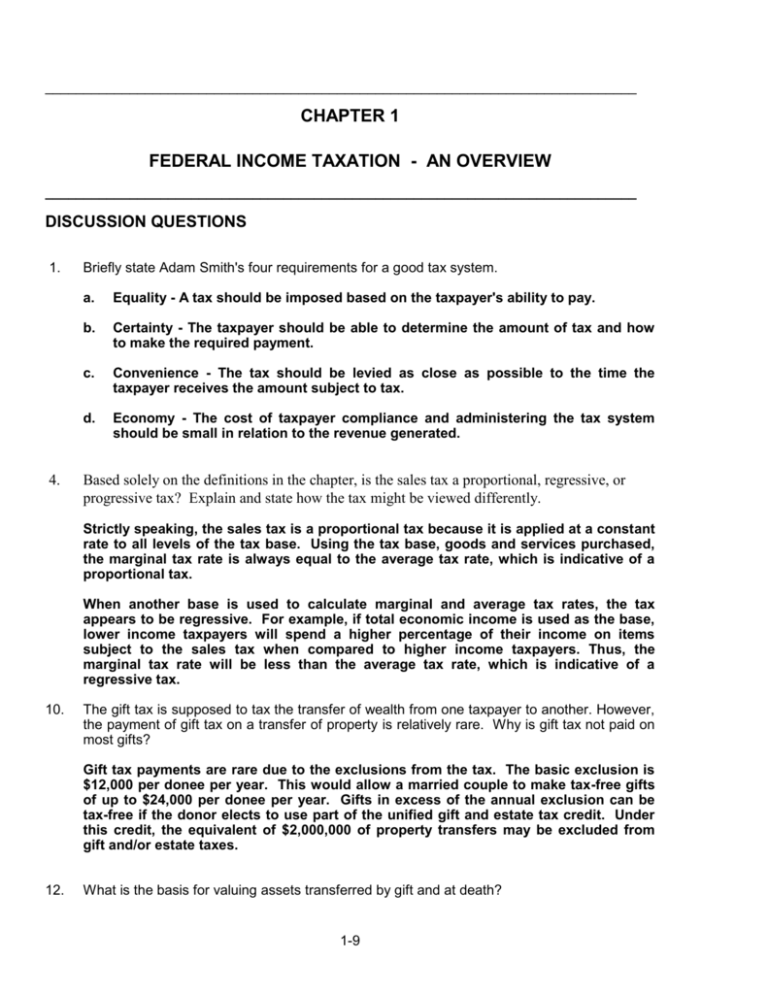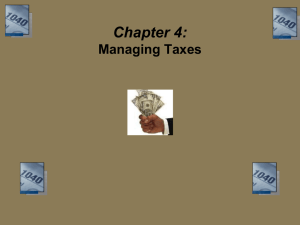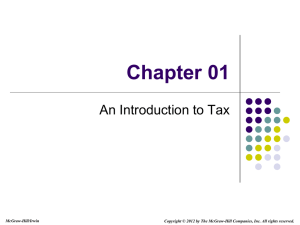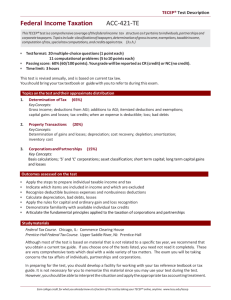Solutions
advertisement

_____________________________________________________________________________ CHAPTER 1 FEDERAL INCOME TAXATION - AN OVERVIEW _____________________________________________________________________________ DISCUSSION QUESTIONS 1. 4. Briefly state Adam Smith's four requirements for a good tax system. a. Equality - A tax should be imposed based on the taxpayer's ability to pay. b. Certainty - The taxpayer should be able to determine the amount of tax and how to make the required payment. c. Convenience - The tax should be levied as close as possible to the time the taxpayer receives the amount subject to tax. d. Economy - The cost of taxpayer compliance and administering the tax system should be small in relation to the revenue generated. Based solely on the definitions in the chapter, is the sales tax a proportional, regressive, or progressive tax? Explain and state how the tax might be viewed differently. Strictly speaking, the sales tax is a proportional tax because it is applied at a constant rate to all levels of the tax base. Using the tax base, goods and services purchased, the marginal tax rate is always equal to the average tax rate, which is indicative of a proportional tax. When another base is used to calculate marginal and average tax rates, the tax appears to be regressive. For example, if total economic income is used as the base, lower income taxpayers will spend a higher percentage of their income on items subject to the sales tax when compared to higher income taxpayers. Thus, the marginal tax rate will be less than the average tax rate, which is indicative of a regressive tax. 10. The gift tax is supposed to tax the transfer of wealth from one taxpayer to another. However, the payment of gift tax on a transfer of property is relatively rare. Why is gift tax not paid on most gifts? Gift tax payments are rare due to the exclusions from the tax. The basic exclusion is $12,000 per donee per year. This would allow a married couple to make tax-free gifts of up to $24,000 per donee per year. Gifts in excess of the annual exclusion can be tax-free if the donor elects to use part of the unified gift and estate tax credit. Under this credit, the equivalent of $2,000,000 of property transfers may be excluded from gift and/or estate taxes. 12. What is the basis for valuing assets transferred by gift and at death? 1-9 1-10 Chapter 1: Federal Income TaxationAn Overview Gift and estate taxes are based on the fair market value of the property at the date of the gift or at the date of death of the taxpayer. 18. How is a deferral different from an exclusion? An exclusion is income that is never subject to tax. A deferral is income that is not taxed in the current period, but will be taxed in a future period. The future period tax may result from inclusion of the income through either lower depreciation/amortization deductions and/or by the inclusion of a larger gain than would have occurred without the deferral. 29. If you were in the 28% marginal tax bracket and you could choose either a $1,000 tax credit or a $3,000 tax deduction, which would give you the most tax saving? Why? The tax credit is a better choice in this case. The tax credit will reduce the tax due by $1,000 (i.e., tax credits directly reduce the amount of tax due). The tax deduction will reduce taxable income by $3,000, resulting in a reduction of the tax due of $840 ($3,000 x 28%). The tax credit gives a $160 ($1,000 - $840) tax advantage to a 28% marginal tax rate payer. The $1,000 tax credit is the equivalent of a $3,571 tax deduction ($1,000 ÷ 28%). 36. How do deductions for adjusted gross income and deductions from adjusted gross income of an individual differ? Deductions for adjusted gross income are limited to those related to a trade or business, reimbursed employee expenses, rental and royalty expenses, alimony paid, one-half of self-employment tax paid, contributions to individual retirement accounts, and other specified expenses. Deductions for adjusted gross income are always deductible - there is no minimum allowable amount. In addition, they generally are not limited by the taxpayer's income. Deductions from adjusted gross income are for certain personal expenditures (medical, interest, taxes, charitable contributions, personal casualty losses) and investment related expenses. Many of these deductions are subject to limitations based on the taxpayer's adjusted gross income. In addition, if the taxpayer's adjusted gross income exceeds a pre-specified amount, total itemized deductions are reduced. A minimum deduction from adjusted gross income is allowed to all taxpayers, called the standard deduction. 42. Explain why each of the following payments does or does not meet the IRS definition of a tax: a. Jack is a licensed beautician. He pays the state $45 each year to renew his license to practice as a beautician. Not a tax. Jack receives a direct benefit from the payment of the licensing fee - he is allowed to practice as a beautician. b. Polly Corporation pays state income taxes of $40,000 on its $500,000 of taxable income. State income taxes are a tax under the IRS definition. The taxes are paid to a governmental authority, are paid pursuant to the state's power to tax, Chapter 1: Federal Income TaxationAn Overview 1-11 are used to provide revenue for the state, and no specific benefit is derived from paying the tax. c. Winona pays $15 annually for a safety inspection of her automobile that is required by the state. Safety inspection fees are not taxes. By paying the fee, Winona is allowed to drive her automobile - a specific benefit is received. d. The Judd Partnership owns land that is valued by the county assessor at $30,000. Based on this valuation, the partnership pays county property taxes of $800. Ad valorem property taxes meet the IRS definition of a tax. The taxes are paid to a governmental authority, are paid pursuant to the county's power to tax, are used to provide revenue for the county, and no specific benefit is derived from paying the tax. e. Andrea fails to file her income tax return on time. She files the return late, and the IRS assesses her $25 for the late filing and $5 for interest on the tax due from the due date of the return until the filing date. The late filing fee and interest charge are not taxes. They are penalties for failing to file a timely tax return. As such, they are used to discourage behavior, not produce revenue. 44. A taxpayer has $95,000 of taxable income for the current year. Determine the total tax, the marginal tax rate, and the average tax rate if the taxpayer is a a. Single individual b. Married couple c. Corporation a. Total tax on $95,000 for a single individual: 2007 single rate schedule Taxable Income Tax on Excess Taxed at Marginal tax rate Total Tax $ 95,000 77,100 $ 17,900 x 28% $ 15,698.75 5,012.00 $ 20,710.75 average tax rate = 21.80% = $20,710.75 tax $95,000 taxable income b. Total tax on $95,000 for a married couple: 2007 married, filing jointly rate schedule Taxable Income Tax on Excess Taxed at Marginal tax rate Total Tax $ 95,000 63,700 $ 31,300 x 25% $ 8,772.50 7,825.00 $ 16,597.50 1-12 Chapter 1: Federal Income TaxationAn Overview average tax rate = 17.47% = $16,597.50 tax $95,000 taxable income c. Total tax on $95,000 for a corporation: 2007 corporate rate schedule Taxable Income Tax on Excess Taxed at Marginal tax rate Total Tax $ 95,000 75,000 $ 20,000 x 34% $13,750 6,800 $20,550 average tax rate = 21.63% = $20,550 tax $95,000 taxable income 46. For each of the following, explain whether the rate structure is progressive, proportional, or regressive: a. Plymouth County imposes a 5% tax on all retail sales in the county. Taxpayers with incomes less than $12,000 receive a refund of the tax they pay. Sales taxes are proportional as defined in the text. The average tax rate is equal to the marginal tax rate on all items subject to the tax. When evaluated using income as the tax base, sales taxes are generally regressive - low income taxpayers spend a higher proportion of their income on goods subject to sales tax (their average tax rates are higher). The refund of the sales tax to taxpayers with lower incomes reduces the regressivity of the tax for those taxpayers. b. The country of Zambonia imposes a 10% tax on the taxable income of all individuals. The income tax is proportional. The average tax rate is equal to the marginal tax rate at all levels of taxable income. However, the tax becomes regressive if higher income taxpayers have a greater ability to lower their taxable income through exclusions and deductions. This lowers the effective rate of tax for high income taxpayers and induces regressivity into the tax structure. c. Regan County imposes a property tax using the following schedule: Assessed Value $ -0- to $10,000 $10,001 to $40,000 $40,001 to $80,000 $80,001 and above Tax $ 40 $ 40 + 1% of the value in excess of $10,000 $ 340 + 2% of the value in excess of $40,000 $1,140 + 3% of the value in excess of $80,000 The property tax is progressive. The marginal tax rates are increasing (1%, 2%, 3%) through the rate structure and are higher than the average tax rate. d. The city of Thomasville bases its dog licensing fee on the weight of the dog per the following schedule: Chapter 1: Federal Income TaxationAn Overview Weight (in pounds) 0 to 40 41 to 80 81 and above 1-13 Tax Rate $ 2 + 50% of weight $22 + 40% of weight in excess of 40 lbs. $36 + 30% of weight in excess of 80 lbs. The dog licensing fee is regressive - marginal tax rates are increasing as the tax base increases. The marginal tax rate is less than the average tax rate. For example, the tax on a 20 pound dog is $12 [2 + (50% x 20)]. The average rate is $.60 and the marginal rate is $.50. The tax on a 50 pound dog is $42 [$22 + (40% x 50)], an average rate of $.84 and a marginal rate of $.40. Average tax rates are increasing with levels of the tax base while marginal tax rates are decreasing. 57. Based on the following information, what are the taxable income and the tax liability for a single individual? Total income Excludable income Deductions for adjusted gross income Deductions from adjusted gross income $103,000 2,000 2,500 6,850 The taxable income for a single individual is $88,250 in 2007: Total Income Excluded Income Gross Income Deductions For Adjusted Gross Income Adjusted Gross Income $103,000 (2,000) $101,000 (2,500) $ 98,500 Deductions From Adjusted Gross Income the Greater of: Itemized Deductions or Standard Deduction $ 6,850 $ 5,350 Personal Exemption Taxable Income (6,850) (3,400) $ 88,250 The tax on $88,250 in 2007 for a single individual is $18,820.75: Taxable Income Tax on Tax on excess Total tax $ 88,250 (77,100) $ 11,150 x 28% $ 15,698.75 3,122.00 $ 18,820.75 63. Art is in the 28% marginal tax bracket for 2007. He owes a $10,000 bill for business expenses. Since he reports taxable income on a cash basis, he can deduct the $10,000 in either 2007 or 2008, depending on when he makes the payment. He can pay the bill at any time before January 31, 2008, without incurring the normal 8% interest charge. If he expects to be in a 33% marginal tax bracket for 2008, should he pay the bill and claim the deduction in 2007 or 2008? 1-14 Chapter 1: Federal Income TaxationAn Overview Art should pay the expense and claim the deduction in 2008. In this case, the marginal tax rate effect (put the deduction in the year with the highest marginal tax rate) is greater than the present value effect (take the deduction as soon as possible) resulting in a real tax savings of $256 by deducting the expense in 2008: Real Tax Savings $ 10,000 x 28% Claim deduction in 2007 Tax savings at marginal rate Claim deduction in 2008 Tax savings at marginal rate Tax savings Present value factor Net real savings from 2008 deduction $ 2,800 $ 10,000 x 33% $ 3,300 x .926 $ 3,056 256 64. Elki would like to invest $50,000 in tax-exempt securities. He now has the money invested in a certificate of deposit that pays 5.75% annually. What rate of interest would the tax-exempt security have to pay to result in a greater return on Elki's investment than the certificate of deposit? Work the problem assuming that Elki's marginal tax rate is 15%, 25%, 28%, and 33%. The equivalent tax-exempt rate is determined by mathematically equating the after-tax rate of a tax-exempt security (TES) with that of a taxable security (TS). The tax paid on the taxable security is paid at the marginal tax rate (MTR). TES RATE = TS - Tax Paid = TS - TS x (MTR) = TS x (1 - MTR) This gives the following tax-exempt equivalent rates for a 5.75% taxable rate: Equivalent Tax-Exempt Rate 4.89% 4.31% 4.14% 3.85% = = = = = Taxable Rate 5.75% 5.75% 5.75% 5.75% x x x x x (1 (1 (1 (1 (1 - MTR) 15.0%) 25.0%) 28.0%) 33.0%) 67. For each of the following situations, state whether the taxpayer's action is tax evasion or tax avoidance: a. Tom knows that farm rent received in cash or farm produce is income subject to tax. To avoid showing a cash receipt on his records, he rented 50 acres for his choice of 5 steers to be raised by the tenant. He used 2 of the steers for food for his family and gave 3 to relatives. Because he did not sell the livestock, he did not report taxable income. Tom's actions would probably be considered tax evasion. Tom knew that farm produce (5 steers) received as rent is income, but he took steps to conceal and not report the income. As a result, he underpaid his income tax. Chapter 1: Federal Income TaxationAn Overview 1-15 b. Betty applied for and received a Social Security number for Kate, her pet cat. Surprised by how easy it was to get a Social Security number, she decided to claim a dependent exemption on her tax return for Kate. Other than being a cat, Kate met all the tests for a dependent. Betty's actions would probably be considered tax evasion. Claiming fictitious dependent deductions is an act often associated with tax protesters. The tax law allows the exemption deduction only for a qualified "individual" which does not include Kate. Betty intentionally claimed a deduction for an amount she knew was not deductible. As a result, Betty underpaid her tax. c. Glen has put money in savings accounts in 50 banks. He knows a bank is not required to report to the IRS interest it pays him that totals less than $10. Because the banks do not report the payments to the IRS, Glen does not show the interest he receives as taxable income. Although Glen's accountant has told him all interest he receives is taxable, Glen insists that the IRS will never know the difference. Glen's actions would probably be considered tax evasion. All income that is not specifically excluded must be reported as income regardless of the amount. Glen had reason to know the interest income was taxable, he took steps to conceal the income and to omit it from his tax return. As a result, Glen underpaid his tax. d. Bob entered a contract to sell a parcel of land at a $25,000 gain in 2006. To avoid reporting the gain in 2006, he closed the sale and delivered title to the land to the buyers on January 2, 2007. Bob's actions are considered tax avoidance and are an acceptable method of planning the timing of income reporting. A sale of land occurs when title passes to the buyer. Bob properly reported the gain in 2007. e. Asha's taxable income for 2007 puts her in the 33% marginal tax bracket. She has decided to purchase new equipment for her business during 2008. A special election allows Asha to treat the $25,000 of the cost of the equipment as a current period expense. Because she expects to be in a lower tax bracket next year, Asha buys and begins using $25,000 worth of the equipment during December 2007. She claims a $25,000 expense deduction under the special election for 2007. Asha's actions would be considered tax avoidance. The $25,000 expense election is available for property placed in service in a trade or business during the year. Asha's decision to purchase the equipment in 2007 to accelerate the tax deduction is an acceptable tax planning technique.






